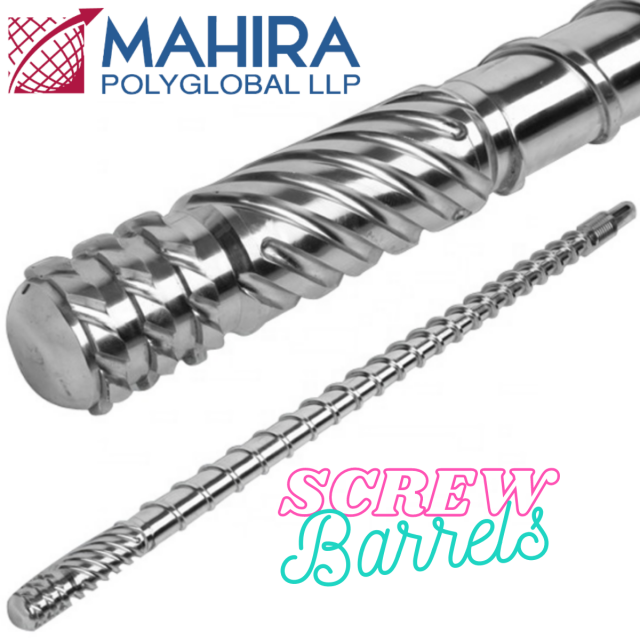In the current competitive marketplace, plastic processors gain an advantage by incorporating a few simple yet effective practices in their operations. In the injection, extrusion or blow molding, the plasticizing unit plays a primary role in production efficiency and determines the end product’s quality. The principal components of screw barrels must be designed in such a way so that it delivers maximum melting efficiency at the original clearances between the interior of the barrel and the exterior diameter of the screw. The approvals are usually kept low to achieve good heat transfer and shear rate.
As soon as the screw begins its rotation inside the barrel, it starts to wear. The wearing occurs either on the screw flights or the barrel’s surface, or both. The harder the processing of the material, the faster the wearing will occur, thereby increasing original clearances and decreasing the melting efficiency. With the decrease in the melting efficiency, most operators tend to compensate by adjusting barrel temperatures, increasing backpressure, increasing screw speed or combining these adjustments.
The operators attempt to avoid longer cycles, unmelted materials, and higher melting temperatures and scrap rates through these adjustments. These changes are usually incremental and go unnoticed until they dramatically impact the part quality or productivity.
Post Contents
Types of Wearing
Screw barrels and extruder screw barrels undergo three types of wearing. Let us identify them:
Abrasive Wear
It is one of the usual type of wearing in plastic machinery, that can be least when manufacturers use low-viscosity polymers. Abrasive wear becomes significant when processing resins with fillers, additives or contaminants. Hard materials tend to remove other materials from softer surfaces. Hence the flight lands are hard-faced with abrasion-resistant alloys.
Adhesive Wear
The adhesive wear occurs when the metal surfaces of screw barrels come in contact. When the extruder screw barrels’ surfaces come in contact and weld together, they experience extremely high stress and then fracture. The manufacturer must check the screw barrels for scoring or galling at the point of damage of the screw located in the barrel.
Corrosive Wear
Corrosion is the gradual destruction of materials by chemical attacks. The atoms of the same metal surface get oxidized, thereby causing damage to the entire surface. The breakdown of the metal surface of the extruder screw barrels allows the surfaces to become vulnerable to the mechanism of mechanical wearing. Screw barrels mostly experience corrosion when processing PVC or polymers in the fluoropolymer family and aggressively attack components that contain a high iron matrix.
Causes of Wear
Straightness, Concentricity and Alignment
While you prepare to install new screw barrels or rebuild one, check that the screw is for straightness and concentricity. Ensure that the screw must slide freely inside the barrel and rotate it with your hand. The screw must rotate freely inside the barrel without any hindrance. It is advisable to align the extruder and blow machines before running the new parts.
Incompatible metals
Since softer materials tend to gall when they contact harder materials, it is important to consider the screw material and the screw flight hardfacing material with their compatibility with the material lining the barrel. You might apply alloys containing lower tungsten carbide, as they are easier to use; however, it does not offer less resistance to wear.
Poor design
When the capacity of the melting section of the screw is lower than the amount of unmelted material, it causes a change to plug with the unmelted material. The pressure forces the screw against the barrel on the opposite side, thereby damaging the screw barrels. The condition often referred to as “solid wedging” occurs when a screw designed for running in a specific resin runs on different polymers at different melting rates.
Abrasive fillers, additives and foreign materials
With polymers and plastics’ applications becoming more specialized and demanding, abrasive fillers and additives necessitated improved protection from wearing and corrosion. Resins containing glass fibers, flame retardants, minerals and stabilizers have a considerable impact on abrasives and corrosive wear in extrusion or molding with these materials. Some of the most aggressive fillers reduce the lives of screw barrels by more than 50%. Another common reason behind the wearing of the screw barrels is the use of foreign materials, such as screwdrivers and grinders, to nuts and bolts.
Conclusion
Careful analysis of the flight wear offers better insight and helps in adopting proper corrective actions. Often huge repairing costs machine downtime, which gets wasted by failing to understand the cause and type of wear.


